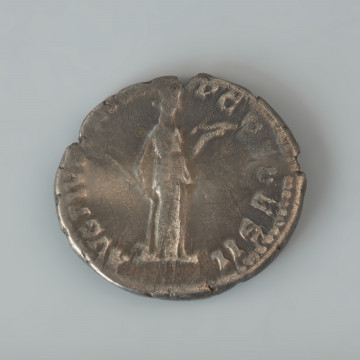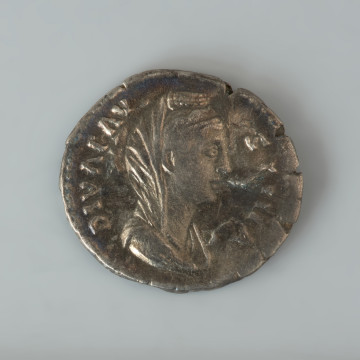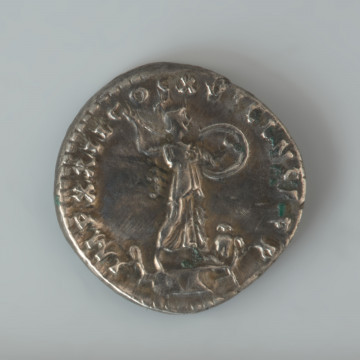
Denarius of Antoninus Pius
National Museum in Szczecin
Part of the collection: Antiquity
The denarius (a silver coin) of the Roman Emperor Antoninus Pius was minted between 139–141 AD in honour of his wife Faustina I, called the Elder (to distinguish her from Faustina the Younger, who was the youngest child of the imperial couple), was discovered in a field during ploughing. The surfaces are worn, although the depictions and inscriptions are still legible. The obverse depicts the Empress Faustina bust turned to the right, with a decorative veil on her head and braided hair. Around the bust, there is the inscription DIVA FAUSTINA. The reverse illustrates the standing figure of Fortuna – goddess of human fortune (both good and bad). On the image she is facing forwards, with her head turned to the right and she holds the Globe in her right, raised hand. A ship’s rudder placed upright is depicted to the left of Fortuna, which represents a symbol of human destiny. The rim on the reverse has the inscription AETERNITAS. From the 1st to the 3rd centuries, the Roman Empire had a substantial impact on populations inhabiting the area of contemporary Poland. That is indicated by the presence of many Roman imported goods, from which the most numerous objects were coins – denarii in particular. Most of those goods were a part of hoards, scattered for multiple reasons. Coins are often discovered separately. Initially, the hoards could have contained dozen to up to several hundred coins. Sometimes, other valuable items made of gold, silver, or amber were also hidden, mostly decorative objects.
Monika Witek
Author / creator
Dimensions
cały obiekt:
Object type
exchaneg media; money; coin; denarius
Technique
forming; punching
Material
silver
Creation / finding place
Owner
Muzeum Narodowe w Szczecinie
Identification number
Location / status

National Museum in Szczecin

National Museum in Szczecin

92 — 93
National Museum in Szczecin
DISCOVER this TOPIC
National Museum in Lublin
DISCOVER this PATH
Educational path